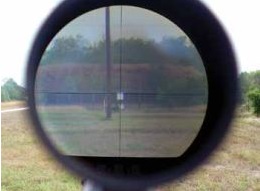How To Correct For Parallax? Parallax Compensation
- Posted By Jeff Byrnes
- Blog
 Okay, so you’ve determined that you have a problem with parallax. Maybe you know about parallax already, or maybe you figured it out from our previous article on parallax and how to figure out if it’s a problem.
Okay, so you’ve determined that you have a problem with parallax. Maybe you know about parallax already, or maybe you figured it out from our previous article on parallax and how to figure out if it’s a problem.
However you came to the conclusion that your parallax is set wrong, you know that you need to correct for it. How do you do that? Here’s a brief rundown on how to correct for parallax.
Not all scopes can do this!
The first thing you need to understand is that only scopes designed for long-range shooting offer adjustable parallax. Most low-magnification tactical style scopes will have negligible or no parallax at all, because the scope is too short or the range is not long enough. Single-power red dot scopes and sights are generally parallax free at any range. Mid-power hunting scopes have very little parallax, and many tactical models don’t have parallax compensation because it’s difficult to quickly and accurately determine range in a fast-moving tactical situation. That leaves us with high-power, long-range scopes.
On these scopes, there is either a side-mount turret at the 9 o’clock position on the tube, across from the windage adjustment turret, or an adjustment ring located on the objective bell. This turret or adjustment ring will allow you to move the focal plane of your target and reticle, thereby eliminating parallax. Sometimes, you’ll find that these adjustment turrets or rings are marked with various distances from 50 yards to infinity, but those markings are not always accurate.
Here is how you can get consistent parallax compensation.
- Begin with the adjustment knob set on the stop past “infinity.”
- Make sure your scope has been sighted in for your rifle
- Establish your rifle in a stable configuration, aimed downrange at your target. Secure your target in a rest or on sandbags to provide stability.
- Place your target at the maximum distance possible, preferably 1,000 yards. Shorter distances will also work, but 1,000 yards is best.
- Set magnification on your scope to maximum.
- Look through your scope and acquire the target.
- Slowly shift your gaze while looking for movement of the reticle in relation to the target.
- Use the parallax compensation turret or objective ring to adjust the reticle and target focal planes until the reticle no longer moves when you shift your gaze.
- Use a fine point marker to mark the proper setting on your ring or turret for this range.
You can repeat this process for different ranges, moving the target closer and marking the parallax settings on your scope. By permanently marking these positions on your ring or turret, you can consistently return to that point any time you are shooting at that range.
This post was written by Jeff Byrnes
Hi there! I’m Jeff, an avid outdoorsman and hunter who really likes exploring new technology. I’m especially into hunting optics, which is why I’m writing these reviews! I hope you find my articles helpful in your own shooting and hunting.








